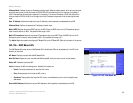
63
Chapter 5: Using the Web-based Utility for Configuration
QoS Tab - CoS Settings
WebView Switches
• A combination of these attributes
Providing various mechanisms for determining the allocation of network resources to different handling classes,
including:
• The assignment of network traffic to a particular hardware queue
• The assignment of internal resources
• Traffic shaping
The terms Class of Service (CoS) and QoS are used in the following context:
CoS provides varying Layer 2 traffic services. CoS refers to classification of traffic to traffic-classes, which are
handled as an aggregate whole, with no per-flow settings. CoS is usually related to the 802.1p service that
classifies flows according to their Layer 2 priority, as set in the VLAN header.
QoS refers to Layer 2 traffic and above. QoS handles per-flow settings, even within a single traffic class.
QoS Tab - CoS Settings
The CoS Settings screen contains fields for enabling or disabling CoS. In addition, the Trust mode can be selected.
The Trust mode relies on predefined fields within the packet to determine the egress queue settings.
The CoS Settings screen has two areas, CoS Settings and CoS to Queue.
QoS Mode. Indicates if QoS is enabled on the interface. The possible values are:
• Disable. Disables QoS on the interface.
• Basic. Enables QoS on the interface.
• Advanced. Enables Advanced mode QoS on the interface. This feature has been added to version 1.2 of
the SRW2024/SRW2016 and version 1.1 of the SRW224G4/SRW248G4.
Class of Service. Specifies the CoS priority tag values, where zero is the lowest and 7 is the highest.
Queue. Defines the traffic forwarding queue to which the CoS priority is mapped. Four traffic priority queues are
supported.
The Restore Defaults button restores the device factory defaults for mapping CoS values to a forwarding queue.
Figure 5-35: QoS - CoS Settings


















